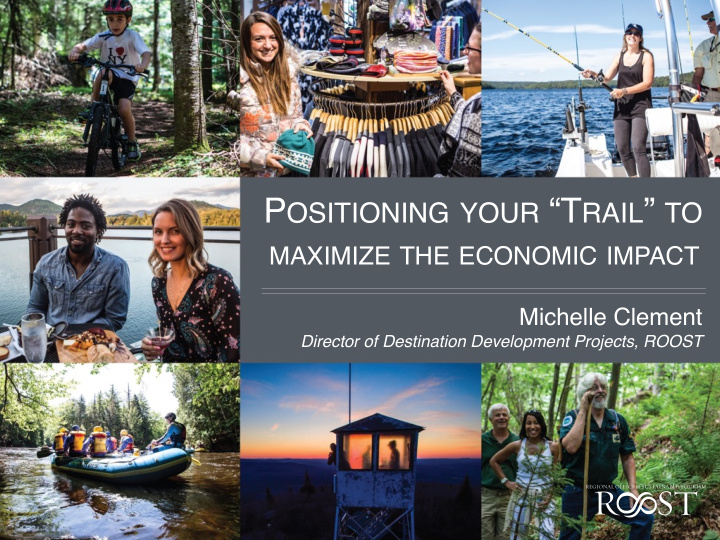



P OSITIONING YOUR “T RAIL ” TO MAXIMIZE THE ECONOMIC IMPACT Michelle Clement Director of Destination Development Projects, ROOST
I NTENT ? • Are you looking to build a “trail” or challenge? • Do you have a “trail” you want to improve or leverage?
G OAL ? Provide an exciting new • option for hiking, biking, etc. Promote a healthy lifestyle. • Improve quality of life for • residents. Put your community on the • “map.” Create an alternative • connection route. Link existing assest. • Increase tourism. • Economic impact. •
T HE ECONOMIC IMPACT “Outdoor recreation is an economic powerhouse in the United States, each year generating $646 billion in consumer spending and 6.1 million direct jobs.” - Outdoor Industry Association
H OW CAN OUR “ TRAIL ” HAVE AN ECONOMIC IMPACT ? A wise man once told me…
S OME QUESTIONS TO CONSIDER … What type of “trail?” • Who is your targeted user group? • What is the current perception this • user group has of your area? What differentiates your “trail” & • community? How are you linking your “trail” back • to your community? Are there gaps in services, amenities, • and infrastructure needed to support this audience? Does your community support & • welcome this user group and the impact the “trail” will have. How does this concept fold in with • other regional “trail” efforts?
W HAT DRIVES TRAVEL ?
P ART OF THE EXPERIENCE …
P ART OF THE EXPERIENCE …
T HEN THERE ARE THE MILLENNIALS !
T HEN THERE ARE THE MILLENNIALS ! They have overtaken the Baby • Boomers. 86% of the children born today • have Millennial parents. Experiences are more important to • them than possessions. Their connection to the outdoors is • strong, but their connection to “non- sporting” activities is even stronger. Their definition of adventure is • different. They’re looking for “itineraries” for • travel inspiration, but that doesn’t necessarily mean they are going to follow them. They want “unique” experiences. •
T HEN THERE ARE THE MILLENNIALS !
M ORE CONSIDERATIONS … Does your “trail” speak solely • to a niche market, or does it reach out to the other 75% of travelers that don’t consider the “outdoors” to be the primary driver of travel? Is your “trail” and your • community positioned to offer the other experiences that travelers are looking for? Do those experiences match? Does your “trail” offer a • “unique” experience? How are you telling the story? •
L EVERAGING THE “T RAIL ” Q UESTIONS ?
Recommend
More recommend